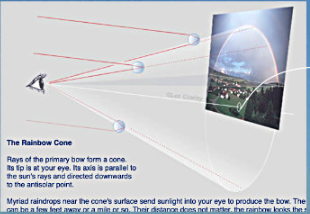Rainbow Wheel
Rainbow Wheel: Exploring the Phenomenon
Have you ever witnessed a captivating optical effect known as the "rainbow wheel"? Marty Malahy was fortunate enough to experience this stunning display one morning on Miramar Beach, Florida. The "rainbow wheel" is an intriguing phenomenon where spokes of lighter sky appear inside a rainbow, forming a wheel-like pattern centered around the antisolar point. In this article, we will delve into the science behind the rainbow wheel and explore its relationship with other atmospheric optics.
A rainbow is a beautiful display of colored glints created by millions of raindrops located on a cone extending from your eye. However, when small clouds obstruct sunlight from reaching certain drops on the cone, sections of the rainbow and the sky within it can appear dimmer. The brighter sky between these cloud-darkened sections gives rise to the spokes that form the mesmerizing rainbow wheel.
The spokes of the rainbow wheel are closely related to another optical phenomenon called antisolar (anticrepuscular) rays. Both phenomena converge towards the antisolar point due to the perspective effect. Distinguishing between spokes and antisolar rays can be challenging as they share similar characteristics and often overlap, blurring the distinction. However, it is their interplay that contributes to the captivating nature of the rainbow wheel.
One fascinating aspect of the rainbow wheel is its potential for creating captivating videos. As clouds move across the sky, the wheel appears to turn, adding a dynamic element to this already enchanting optical phenomenon. Capturing these videos allows us to witness the continuous transformation of the rainbow wheel, providing a deeper appreciation for its beauty and complexity.
To fully comprehend the science behind the rainbow wheel, it is crucial to understand the concept of the antisolar point. The antisolar point is located directly opposite the sun in the sky. Many optical effects, including the rainbow wheel, are centered around this point. By considering the antisolar point as the focal point, we can better appreciate the intricate interplay between light, raindrops, and atmospheric conditions that give rise to the rainbow wheel.
It is important to note that this article has been automatically converted from the old site and may not appear as intended. Nevertheless, the information provided here offers valuable insights into the phenomenon of the rainbow wheel. For further exploration and original content, you can refer to the link provided at the end of this article.
In conclusion, the rainbow wheel is a captivating optical phenomenon characterized by spokes of lighter sky within a rainbow, forming a wheel-like pattern centered around the antisolar point. The interplay between cloud-darkened sections and brighter sky gives rise to this mesmerizing display. Understanding the relationship between the rainbow wheel and other atmospheric optics, such as antisolar rays, enhances our appreciation for the complexity and beauty of these natural phenomena. Next time you find yourself gazing at a rainbow, keep an eye out for the enchanting rainbow wheel that may be spinning silently in the sky.
Note: The original article can be found here.

Rainbow Wheel
Marty Malahy saw this one morning on Miramar Beach,
Florida.

The previous Atoptics Highlight/OPOD championed the antisolar point as the centre of many optical effects. The "rainbow wheel" is another. "Spokes" of lighter sky appear inside a rainbow and centred of course on the rainbows centre, the antisolar point.

A rainbow is the coloured glints of millions of raindrops located on a cone extending from your eye. Small clouds can block sunlight from drops on the cone, dimming a section of the bow and the sky inside it. Brighter sky between the cloud darkened sections makes the spokes.
Spokes are closely related to antisolar (anticrepuscular) rays and they converge towards the antisolar point by the same perspective effect. It is often hard to tell them apart and the distinction is a fuzzy one.
Rainbow wheels make fine videos, the wheel turns as clouds cross the sky.
Note: this article has been automatically converted from the old site and may not appear as intended. You can find the original article here.
Reference Atmospheric Optics
If you use any of the definitions, information, or data presented on Atmospheric Optics, please copy the link or reference below to properly credit us as the reference source. Thank you!
-
<a href="https://atoptics.co.uk/blog/rainbow-wheel/">Rainbow Wheel </a>
-
"Rainbow Wheel ". Atmospheric Optics. Accessed on November 26, 2024. https://atoptics.co.uk/blog/rainbow-wheel/.
-
"Rainbow Wheel ". Atmospheric Optics, https://atoptics.co.uk/blog/rainbow-wheel/. Accessed 26 November, 2024
-
Rainbow Wheel . Atmospheric Optics. Retrieved from https://atoptics.co.uk/blog/rainbow-wheel/.